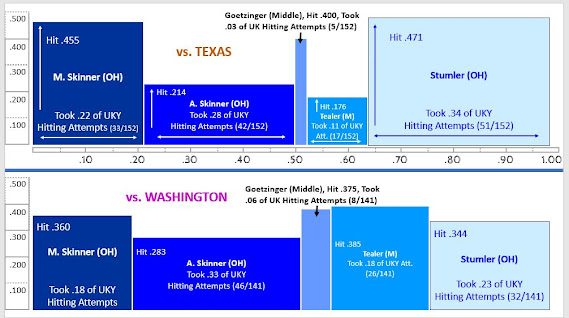It was an unusual spring for U.S. collegiate volleyball, thanks to COVID-19-related adjustments, with the women's championship (typically decided in December) and the men's championship (typically being decided five months later) being held only two weeks apart. The women's final was played on Saturday, April 24, 2021, with the men's on May 8. Having nearly three months to digest these matches, I present my analyses of the championships below.
WOMEN'S
For starters, here's a sentence I never expected to write in my lifetime (I'm 58): The Kentucky Wildcats are the new NCAA women's volleyball champions.* UK stopped Texas in four games, 20-25, 25-18, 25-23, 25-22, to claim what really is the 2020 championship (the 2021 title will be determined this coming November).
True, Kentucky was the No. 2 seed. However, previous high seeds from outside the power conferences (Big 10, Big 12, Pac 12) have rarely lived up to their placements**, so I remained skeptical. In the end, however, Kentucky proved to be a more reliable pick than even No. 1 seed Wisconsin, which entered the tournament undefeated, but bowed out in three to No. 4 Texas in the national semifinals.
Kentucky led the nation in team hitting percentage during the regular season (.361) and, to a large extent, rode that hitting to the national championship. Wisconsin came out better than Kentucky on my Conference-Adjusted Combined Offensive-Defensive (CACOD) measure, which is based on each team's own regular-season hitting percentage (HP) divided by the aggregate hitting percentage a team allowed its opponents (with this ratio multiplied by a strength-of-conference adjustment factor). Wisconsin hit .342 in the regular season (a bit below Kentucky's .361), but the Badgers allowed their opponents to hit a combined .128 (compared to .144 for the Wildcats' opponents). The Big 10's higher conference strength (1.25) than the SEC's (1.00) also made Wisconsin look better:
Wisconsin: .342 own HP/.128 opponents' HP = 2.67, which when multiplied by the Big 10's 1.25 conference adjustment factor = 3.34.
Kentucky: .361 own HP/.144 opponents' HP = 2.51, which when multiplied by the SEC's 1.00 conference adjustment factor = 2.51.
At no time was Kentucky's kill-production more effective than when the Wildcats had the opportunity to close out the championship match against Texas in Game 4. Looking at a portion of the Game-4 play-by-play, once the Wildcats had overcome the Longhorns' early 6-1 edge to take a 15-13 lead, Kentucky successfully kept Texas at arm's length. A trailing team cannot afford merely to trade side-outs, but must put together scoring runs on its own serve to catch up. Yet, as shown in the following screenshots, five of Texas's seven final serving stints consisted of one serve only (the other two consisting of two serves). And, nearly always, it was Kentucky kills (highlighted in yellow) that kept Texas from gaining any ground. (You can click on all graphics to enlarge them.)
Looking at Kentucky's graphs against Texas and Washington one atop the other allows us to discern at a glance any changes in the Wildcats' allocation strategy between the two matches. For example, Kentucky set Stumler considerably more often (34% of the team's hitting attempts) in the final match than in the semifinal (23%). Changes in players' hitting percentages, such as Madi Skinner's improvement from .360 in the semifinal to .455 in the final, are also evident.
MEN'S
Due to the COVID-related cancellation of the 2020 NCAA men's season, 2019 runner-up Hawai'i had to wait two years for another shot at the title. This time, the Rainbow Warriors made good on the opportunity, sweeping BYU, 25-21, 25-19, 25-16.
As this match wore on, Hawai'i looked more and more like it could attack the ball unchallenged. BYU recorded a healthy 5.5 blocks in Game 1 (really 5, as the extra half-block comes from awarding .5 credit to three blockers who went up together). However, the Cougars had zero blocks in Game 2 and two in Game 3 (7.5 total). Hawai'i hit .381 for the match (.400, .333, and .400, respectively, in Games 1, 2, and 3). Also, the Rainbow Warriors had only nine hitting errors on the night; we know seven of these are from BYU's "7.5" blocks, so that means UH spiked only two balls out of bounds.
The Bows' Rado Parapunov, who started off hot in the 2019 final before cooling off, hit .357 this time vs. BYU on 13 kills (with three errors) on 28 swings (one-third of Hawai's overall 84 spike attempts). Several of Parapunov's teammates had even higher hitting percentages, albeit in far fewer attempts (Patrick Gasman, .545, 7-1-11; and Chaz Galloway and Guilherme Voss, each .667, 6-0-9).
Before I go, I wanted to mention that the Hawai'i athletic website's box score from this match is a very elaborate one, containing far more than the usual statistics. As shown in the following screenshot, the extended box score breaks down hitting attempts into first-ball attacks (immediately upon serve-receipt), transition attacks (once a rally has started), and first transition attacks. Hawai'i hit better on first-ball attacks (.524) than it did on transition attacks (.238).
---
*Any more than I expected to write about a post-1908 World Series win by the Chicago Cubs or an NBA title by the Toronto Raptors (2019) or Milwaukee Bucks (2021).
**Examples include the 2019 Pitt squad that was seeded No. 6 and lost in the second round, and Kentucky itself, which as the No. 4 seed in 2017, lost in the Elite Eight to Nebraska.
***In the usual 64-team field, a team must win four matches to reach the Final Four. However, due to COVID, this spring's NCAA tourney consisted of only 48 teams.





